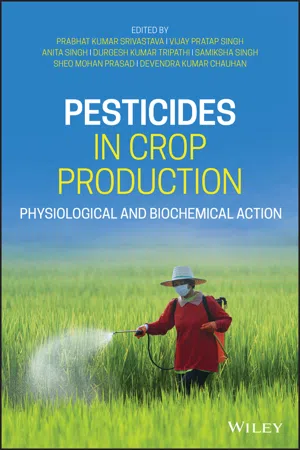
Pesticides in Crop Production
Physiological and Biochemical Action
- English
- ePUB (mobile friendly)
- Available on iOS & Android
Pesticides in Crop Production
Physiological and Biochemical Action
About this book
A guide to the diversity of pesticides used in modern agricultural practices, and the relevant social and environmental issues
Pesticides in Crop Production offers an important resource that explores pesticide action in plants; pesticide metabolism in soil microbes, plants and animals; bioaccumulation of pesticides and sensitiveness of microbiome towards pesticides. The authors explore pesticide risk assessment, the development of pesticide resistance in pests, microbial remediation of pesticide intoxicated legumes and pesticide toxicity amelioration in plants by plant hormones.
The authors include information on eco-friendly pest management. They review the impact of pesticides on soil microorganism, crops and other plants along with the impact on other organisms like aquatic fauna and terrestrial animals including human beings. The book also contains an analysis of pesticide by GC-MS/MS (Gas Chromatography tandem Mass Spectrometry) a reliable method for the quantification and confirmation of multiclass pesticide residues. This important book:
- Offers a comprehensive guide to the use of the diversity of pesticides and the pertinent social and environmental issues
- Explores the impact of pesticides from morphological, anatomical, physiological and biochemical perspectives
- Shows how pesticides affects soil microorganisms, crops and other plants along with the impact on other organisms like aquatic fauna and animals
- Critically examines whether chemical pesticides are boon or bane and whether they can be replaced by environmental friendly pesticides
Written for students, researchers and professionals in agriculture, botany, entomology and biotechnology, Pesticides in Crop Production examines the effects of chemical pesticides and the feasibility of using bio-pesticides.
Frequently asked questions
- Essential is ideal for learners and professionals who enjoy exploring a wide range of subjects. Access the Essential Library with 800,000+ trusted titles and best-sellers across business, personal growth, and the humanities. Includes unlimited reading time and Standard Read Aloud voice.
- Complete: Perfect for advanced learners and researchers needing full, unrestricted access. Unlock 1.4M+ books across hundreds of subjects, including academic and specialized titles. The Complete Plan also includes advanced features like Premium Read Aloud and Research Assistant.
Please note we cannot support devices running on iOS 13 and Android 7 or earlier. Learn more about using the app.
Information
1
Development of Pesticide Resistance in Pests: A Key Challenge to the Crop Protection and Environmental Safety
1.1 Resistance: The Introduction
1.2 Pesticide Resistance: A Global Analysis
1.3 Molecular Genetics and Biochemical Basis of Pesticide Resistance

1.4 Changes in Pesticide Binding Sites
Table of contents
- Cover
- Table of Contents
- List of Contributors
- Preface
- 1 Development of Pesticide Resistance in Pests: A Key Challenge to the Crop Protection and Environmental Safety
- 2 Fungicide Toxicity to Legumes and Its Microbial Remediation: A Current Perspective
- 3 Pesticide Metabolism in Plants, Insects, Soil Microbes and Fishes: An Overview
- 4 Bioaccumulation of Pesticides and Its Impact on Biological Systems
- 5 Impact of Pesticide Exposure and Associated Health Effects
- 6 Microbiome as Sensitive Markers for Risk Assessment of Pesticides
- 7 Arms Race between Insecticide and Insecticide Resistance and Evolution of Insect Management Strategies
- 8 Agricultural Herbicides and Fungi in Soil Exposed to Herbicides
- 9 Pesticides Usage, Uptake and Mode of Action in Plants with Special Emphasis on Photosynthetic Characteristics
- 10 Botanical Pesticides for Eco‐Friendly Pest Management: Drawbacks and Limitations
- 11 Pesticide Interactions with Foodstuffs: Case Study of Apple
- 12 Multiresidue Pesticide Analysis in Cabbage and Cauliflower Using Gas Chromatography Tandem Mass Spectrometry (GC‐MS/MS)
- 13 Pesticide Toxicity Amelioration in Plants by Plant Hormones
- 14 Transgenic Strategies to Develop Resistant Plant Against the Pathogen and Pest
- Index
- End User License Agreement